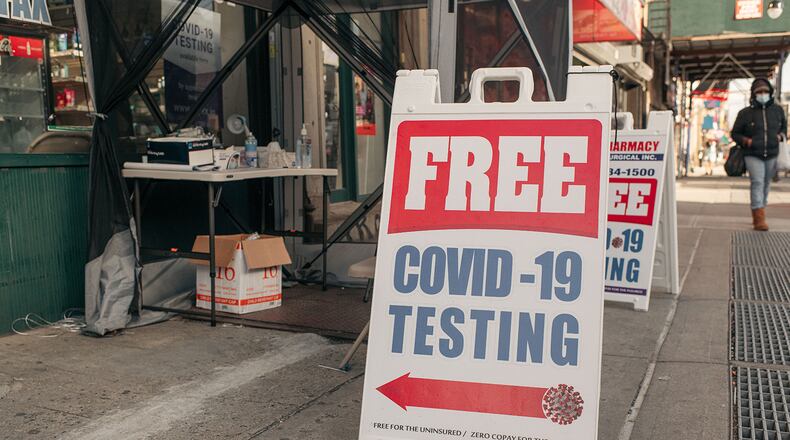In the daily deluge of COVID-19 data, it can be difficult to find answers to key questions:
How bad is it?
What should you do about it?
Data collection practices around COVID-19 have evolved, complicating their interpretation. And with those changes, we need to update how we understand the kinds of numbers we’ve become all-too familiar with.
While cases and hospitalizations still indicate the status and urgency of the pandemic, interpreting them today presents new challenges.
At the beginning of the pandemic, with limited testing, reported cases didn’t fully capture the spread of the virus.
Today, testing is much more widespread and the United States has made at-home testing far more accessible.
The catch?
The results of these home tests don’t get included in the reported case numbers. It’s unknown just how much the numbers undercount reality, but the problem will likely grow with the rise of home testing.
Credit: contributed
Credit: contributed
Secondly, hospitalizations can reflect increased transmission, not necessarily severity. As a result, those hospitalization numbers can suggest an inflated view of the number of severe COVID-19 cases.
The data don’t distinguish between people who are hospitalized because of COVID-19 from those who are admitted and happen to test positive for it.
Even though omicron is less likely to cause severe disease requiring hospitalization, especially among the vaccinated, hospitals were overrun because so many people contracted it.
And every COVID-positive patient increases the exposure risk to staff and takes up precious bed space.
Even though how we interpret some of the data has changed, there are still some guiding principles experts widely agree on.
Get vaccinated, but know it’s not bulletproof.
Vaccines continue to be effective at preventing severe disease and hospitalization. And booster shots help shield people from the worst outcomes, particularly those who are older.
It’s important to remember that vaccines don’t make you invincible. They reduce the relative risk of contracting the virus.
Public health experts recommend a multi-layered approach: measures like getting vaccinated, wearing masks and social distancing don’t substitute for one another but can be used together to maximize individual and community protection.
Add layers of protection as risk increases.
Deciding exactly how cautious to be — particularly when socializing — is challenging. Data show the virus is often contracted in social settings. Beyond limiting interactions, people have other tools at their disposal: rapid-testing, masking, increasing ventilation and gathering outdoors as the weather gets warmer.
Data frequently lag, so be proactive.
Data represent a picture of the past, even when reporting systems operate perfectly. Test results can take days to identify cases. Hospitalization numbers spike after case numbers because the virus takes time to cause severe disease. And deaths lag even further behind.
Reporting delays can engender a false sense of security in people trying to make sense of COVID-19 in the moment. Whatever the daily numbers show, the virus rewards being proactive.
The data can provide glimpses of the status of the pandemic and indications of how individuals and policymakers should respond.
But don’t focus on cases, hospitalizations, or deaths to know when exactly this all ends.
Public health officials generally agree that the eradication of COVID-19 is off the table.
Sure, there’s a mathematical definition of when a pandemic becomes endemic instead, like the flu.
But that won’t tell you when you don’t have to think about COVID-19 as much.
What people may want to know is what our collective sacrifices are trying to achieve, and when they may no longer be necessary.
The answer to that question is unchanged from March 2020, said Michael LeVasseur, professor of epidemiology and biostatistics at Drexel University’s School of Public Health in Philadelphia: Prevent the healthcare system from being overwhelmed.
And remember, the full toll of the pandemic goes beyond daily numbers.
A big worry for experts is how hospital strain led to the cancellation or postponement of so-called elective surgeries. They aren’t necessarily optional procedures; many are essential. They are often only elective in that they don’t have to happen immediately, but postponement over long periods of time can still cost lives.
COVID-19 cases and deaths also don’t capture costs to mental health, educational equity, social mobility, or housing and food security that people have borne for two years.
Those damages will reverberate for generations. And pandemic recovery defined more broadly will be a years-long effort — no matter what the numbers say today.
This story first appeared in The Philadelphia Inquirer and is distributed by Tribune Content Agency.
About the Solutions Journalism Network
Each week, as part of our solutions-oriented focus, The Atlanta Journal-Constitution partners with the Solutions Journalism Network, a nonprofit organization dedicated to rigorous reporting about social issues. This week’s content comes from other sources.
Resources about COVID-19 in Georgia
Daily dashboard with updated stats from AJC
About the Author
Keep Reading
The Latest
Featured



